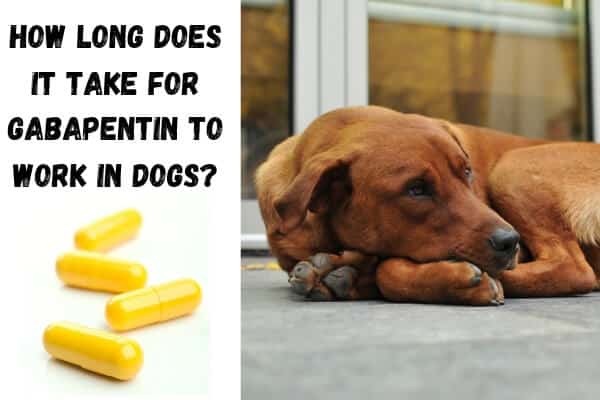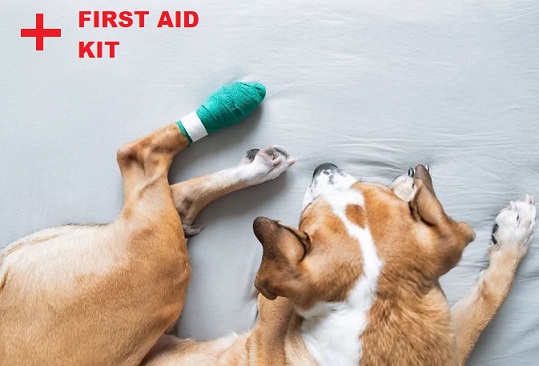How Long Does It Take For Gabapentin To Work In Dogs?

When our beloved four-legged companions experience discomfort, we want to ensure they find relief swiftly. Just like humans, dogs can suffer from various conditions that cause pain, stress, and anxiety. Thankfully, veterinary medicine has a solution in the form of Gabapentin, a medication commonly prescribed to manage neuropathic pain and seizures.
Gabapentin’s efficacy in dogs is truly impressive, as it typically takes about 1 to 2 hours for the medication to take effect and for your dog to start feeling relief. Upon administration, this anticonvulsant drug swiftly targets nerve-related pain and anxiety, helping our furry friends feel more comfortable and at ease.
Gabapentin is commonly prescribed to dogs for various conditions, including chronic pain, arthritis, nerve pain, and as a preoperative sedative to reduce stress. While it acts quickly, the duration of its effectiveness varies depending on the dog’s individual response and the specific condition being treated. As with any medication, it’s essential to follow your veterinarian’s guidelines and dosage instructions for your furry friend’s well-being.
Read Also: How Long Does It Take For Gabapentin To Work In Cats?
Jump to Section
How Long Does It Take For A Gabapentin To Work In Dogs?
Gabapentin is a commonly used medication in veterinary medicine to manage pain and anxiety in dogs. As an anticonvulsant drug, it offers various benefits for treating different conditions in canine patients. When administered to dogs, it usually takes effect within 1 to 2 hours and lasts for 24-48 hours. However, the onset of action can be influenced by factors such as the dog’s individual response, the prescribed dosage, and whether it’s given with or without food.
For dog owners, it is crucial to adhere closely to the veterinarian’s prescribed dosage and instructions to ensure the safe and effective administration of gabapentin to their furry companions. Since each dog’s response to medication can vary, some may show improvement faster than others, while others may take a bit longer.
Regular monitoring by the veterinarian is essential to assess the dog’s response to gabapentin and make any necessary adjustments to the treatment plan. Being vigilant about any potential adverse effects or unexpected reactions is vital while the dog is on the drugs
How Long Does Gabapentin Stay In Your Dog’s System?
Gabapentin has a relatively short duration of action in a dog’s system. After administration, it is absorbed into the bloodstream and undergoes metabolism in the liver. The drug’s half-life, which is the time it takes for half of the medication to be eliminated from the body, ranges from 3 to 4 hours in dogs. This means that after 24 hours, most of the gabapentin will have been cleared from the dog’s system.
Several factors can also influence how long gabapentin stays in a dog’s system. These include the dog’s size, age, and overall health condition. Larger dogs might metabolize the drug more rapidly than smaller dogs, and younger, healthier dogs may process it faster than older or sickly ones. Additionally, liver and kidney function play a crucial role in drug elimination, so dogs with impaired organ function may take longer to clear gabapentin from their systems.
Pet owners need to adhere to the veterinarian’s prescribed dosage and administration schedule. If any adverse reactions or changes in the dog’s condition are noticed, it is essential to seek immediate veterinary advice.
How Does Gabapentin Work in Dogs?
Commonly known by the brand name Neurontin, Gabapentin works by targeting the central nervous system of your dog. It belongs to the class of drugs known as anticonvulsants, which means it was originally developed to control seizures in humans. However, veterinarians also prescribe gabapentin for dogs to manage various conditions related to nerve pain and anxiety.
This drug works by modulating the activity of certain neurotransmitters, particularly gamma-aminobutyric acid (GABA). GABA is an inhibitory neurotransmitter that helps to regulate brain activity and reduce neuronal excitability. When gabapentin is administered, it increases the release of GABA and enhances its effects on the brain. This leads to a decrease in the transmission of pain signals along the nerves, providing relief from neuropathic pain, which is pain caused by nerve damage or dysfunction.
In addition to its pain-relieving properties, gabapentin can also have a calming effect on dogs with anxiety or nervous disorders. The increased GABA activity helps to reduce the overall excitability of the central nervous system, promoting a sense of relaxation and tranquility. Veterinarians may prescribe gabapentin for dogs experiencing anxiety due to separation, noise phobias, or other stress-inducing situations.
Overall, gabapentin is an essential tool in veterinary medicine for managing nerve-related pain and anxiety in dogs. Its mechanism of action involves enhancing GABA activity, leading to pain relief and relaxation. However, like any medication, gabapentin should only be used under the guidance of a veterinarian and following their recommended dosage and treatment plan.
Gabapentin Dosage Requirement For Dogs
The appropriate gabapentin dosage for dogs varies based on their weight, health, and the specific condition being treated. Typically, the dosage ranges from 2.5 to 5 milligrams per pound of body weight, administered two to three times daily. For instance, a 50-pound dog may receive between 125 to 250 milligrams of gabapentin per dose.
It’s crucial to strictly follow the veterinarian’s prescribed dosage and schedule. Always carefully read the label of gabapentin intended for your dog, especially the liquid form as some formulations may contain xylitol, which is toxic to dogs. Below is the general dosage per weight for administering gabapentin.
Dog Weight (lbs) Gabapentin Dosage (mg)
10 | 25 – 50
20 | 50 – 100
30 | 75 – 150
40 | 100 – 200
50 | 125 – 250
60 | 150 – 300
70 | 175 – 350
80 | 200 – 400
90 | 225 – 450
100 | 250 – 500
Remember that this is a general guideline, and the actual dosage may vary depending on your dog’s specific condition and your veterinarian’s recommendations. Always follow your vet’s instructions carefully and monitor your dog for any adverse reactions while on gabapentin.
If you mistakenly give your dog an extra dosage or overdoze your dog, read my in-depth study of the effects of this on dogs.
When Is The Best Time To Give Gabapentin To Your Dog?
In general, gabapentin is given orally, and the best time to administer it can vary depending on the purpose of the medication. When managing neuropathic pain or seizures, gabapentin is usually given two to three times daily, at 8-hour intervals. This helps maintain a steady level of the medication in the dog’s system, providing consistent pain relief or seizure control throughout the day.
For dogs experiencing anxiety or stress-related issues, veterinarians may recommend giving gabapentin about one to two hours before the anticipated trigger event. This approach allows the gabapentin to take effect before the anxiety triggers occur, helping your dog remain calmer during the event.
Always follow your veterinarian’s specific instructions regarding the dosing schedule for gabapentin. They will consider your dog’s health condition to determine the most suitable time for administering the medication. Consistency is key, so try to give the doses at the same time each day. Additionally, keep an eye on your dog’s response to gabapentin and report any concerning side effects to your vet promptly.
Can Gabapentin Interact With Other Medications?
Like many drugs, Gubalentin has the potential to interact with other medications, which can lead to adverse effects or reduce the effectiveness of either drug.
1. Central Nervous System Depressants
Gabapentin can enhance the effects of other central nervous system depressants, such as opioids, benzodiazepines, and muscle relaxants. This combination may lead to increased drowsiness, sedation, and impaired cognitive function.
2. Antacids
Taking gabapentin with antacids that contain aluminum and magnesium hydroxide can reduce its absorption in the body. To avoid this interaction, it is best to take gabapentin at least two hours before or after antacid consumption.
3. Naproxen
Co-administration of gabapentin and naproxen, a nonsteroidal anti-inflammatory drug (NSAID), may increase the risk of kidney damage.
4. Probenecid
Probenecid, a medication used to treat gout, can reduce the elimination of gabapentin from the body, leading to increased levels of the drug and a higher risk of side effects
5. Opioids
Taking gabapentin with opioids, such as oxycodone or hydrocodone, can increase the risk of respiratory depression, sedation, and even death. The combination of these drugs should be carefully managed, and lower doses may be required to minimize potential risks.
6. Diuretics
Some diuretics, like hydrochlorothiazide, can lead to decreased blood levels of gabapentin, potentially reducing its effectiveness. Monitoring the therapeutic response of gabapentin may be necessary when diuretics are prescribed or adjusted.
7. Alcohol
Combining gabapentin with alcohol can potentiate central nervous system depression and impair motor function. Patients should avoid alcohol while taking gabapentin, especially if they are driving or operating heavy machinery.
8. Interactions With Medications Metabolized By The Liver
Gabapentin is primarily eliminated from the body through the kidneys, so it has limited interactions with drugs metabolized in the liver. However, caution should be exercised when combining gabapentin with other medications that have potential interactions, and monitoring may be required.
Side Effects Of Gabapentin On Dogs
1. Drowsiness and Sedation
Gabapentin can cause drowsiness and sedation in dogs. The drug affects the central nervous system, leading to a calming effect that may make the dog feel lethargic or excessively sleepy. While this can be beneficial for managing anxiety or certain types of pain, it can also hinder the dog’s normal activity levels and alertness.
2. Stomach Upset and Diarrhea
Some dogs may experience gastrointestinal disturbances when taking gabapentin. This can manifest as stomach upset, including symptoms like nausea, vomiting, and diarrhea. The drug may irritate the digestive tract or cause changes in gut motility, leading to these adverse effects. It is essential to monitor the dog’s eating habits and bowel movements to ensure they tolerate the medication well.
3. Loss of Coordination
Gabapentin can affect a dog’s motor skills and coordination. This may result in a lack of balance or clumsiness, particularly in older dogs or those with pre-existing mobility issues. Owners should exercise caution during walks and other activities to prevent accidents or falls.
4. Behavioral Changes
Some dogs may exhibit behavioral changes while on gabapentin. These can include increased lethargy or unusual shifts in temperament, such as heightened aggression or excessive fearfulness. Monitoring a dog’s behavior is crucial to ensure the medication does not negatively impact its quality of life.
Do Dogs Get Sleepy From Taking Gabapentin?
Yes, Gabapentin can make dogs sleepy. As an anticonvulsant and analgesic medication, it acts on the central nervous system to reduce nerve signals associated with pain and seizures. When administered, the drug can induce a calming effect on the dog’s nervous system, leading to increased sleepiness and reduced activity levels.
The sedative property of gabapentin can be advantageous in certain situations, especially when dogs are experiencing anxiety, discomfort, or pain. It can help them relax and rest, which may aid in their overall recovery process. Nevertheless, it’s paramount for pet owners and veterinarians to find the right balance in dosage to avoid excessive drowsiness that could interfere with the dog’s normal daily activities.
What Happens If I Give My Dog Too Much Gabapentin?
If your dog ingests an excessive amount of gabapentin, it can result in severe consequences. Overdosing on gabapentin may lead to pronounced sedation, causing your dog to become extremely lethargic and unresponsive. They may struggle to stay alert and could exhibit signs of drowsiness and disorientation. Additionally, gastrointestinal issues like vomiting and diarrhea may manifest, potentially leading to dehydration and electrolyte imbalances, which can further worsen your dog’s condition.
In more critical situations, an overdose of gabapentin can induce respiratory depression and a decrease in heart rate, posing life-threatening risks to your furry companion. If you suspect your dog has consumed too much gabapentin or notice any concern, prompt intervention can ensure the appropriate measures are taken to counteract the overdose’s effects and provide the necessary support for your dog’s well-being and recovery.
Final Thoughts
The onset of action for gabapentin in dogs varies, but it typically begins within one to two hours after administration. However, the full effects may take several days of consistent dosing to be fully realized. It is essential to follow the veterinarian’s recommended dosage and administration schedule to achieve the desired therapeutic outcomes.
Monitoring the dog’s response to the medication and communicating any concerns with the veterinarian can ensure optimal results while minimizing potential side effects. Remember that each dog may react differently to gabapentin, and individual responses can be influenced by factors such as the dog’s size, medical condition, and metabolism.
Patience is key during the treatment process, and adjustments to the dosage or treatment plan may be necessary to find the most effective approach for your furry companion. Always consult with a qualified veterinarian for proper guidance and to ensure your dog’s health and well-being.
Read related posts about





